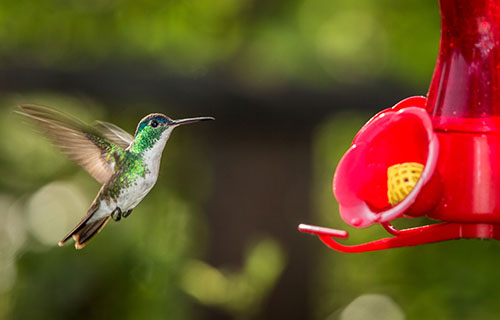Hanging your Hummingbird Feeders
May 09, 2022

Spring migration of Ruby-throated Hummingbirds has begun to slow for the next couple of months as nesting season begins. After summer resident hummingbirds have concluded raising their broods of offspring, you will likely see this growing family coming to your feeder in search of fresh nectar. Later in August, hummingbirds will once again ramp up their interest in feeders as their migration back to the Gulf of Mexico begins.
Use this down-time between peak seasons to plan the perfect location to hang your hummingbird feeder by following the three tips below. After all, location is the key factor in keeping these birds coming back to your yard over and over again.
Look for shade
Watch the pattern of sunlight in your yard at various points throughout the day. The early morning, when the sun’s rays are at their weakest, provides the best source of warmth for hummingbirds. Hang your feeder on the north or east side of your house to give them access to this morning sunlight while keeping them protected during the hottest part of the day. Consider placing your feeder under a tree, roofline, or covered porch that will provide shade and easy access. Keeping your feeder out of direct sunlight when the sun’s rays are strongest will also help your nectar to last longer without spoiling.
Avoid windows
Hummingbirds are often called “the fighter pilots of the avian world” and are known as one of the most agile fliers in the animal kingdom. However, with flight speeds of up to 35 miles per hour, it is no surprise that accidental collisions can occur, especially around low-visibility objects such as glass. For your hummingbirds’ safety, it is recommended to hang feeders at least three feet away from windows. If you are trying to get a good view of them from inside your house, though, use a feeder with suction cups that attach directly to the window. Hummingbirds will automatically slow down to approach the feeder, keeping them safe from fatal collisions.
Grow a flower garden
Hummingbirds may be tiny, but they have big appetites. Sugar water is not the only nutritional meal that these birds need, though — they need other sources of nectar as well. Planting a flower garden filled with nectar-rich blooms and hanging a feeder from a shepherd’s hook in the center is practically like offering an all-you-can eat buffet to these little birds. Hummingbirds especially love tubular-shaped, brightly colored flowers such as bee balms, daylilies, foxgloves, columbines, zinnias, and petunias.
Your local-Co-op carries hummingbird supplies such as feeders and nectar, as well as seed, feeders, and birdhouses for many other types of birds as well. Click here to find the nearest Co-op location.
For more content like this, check out the latest issue of the Cooperator.
Use this down-time between peak seasons to plan the perfect location to hang your hummingbird feeder by following the three tips below. After all, location is the key factor in keeping these birds coming back to your yard over and over again.
Look for shade
Watch the pattern of sunlight in your yard at various points throughout the day. The early morning, when the sun’s rays are at their weakest, provides the best source of warmth for hummingbirds. Hang your feeder on the north or east side of your house to give them access to this morning sunlight while keeping them protected during the hottest part of the day. Consider placing your feeder under a tree, roofline, or covered porch that will provide shade and easy access. Keeping your feeder out of direct sunlight when the sun’s rays are strongest will also help your nectar to last longer without spoiling.
Avoid windows
Hummingbirds are often called “the fighter pilots of the avian world” and are known as one of the most agile fliers in the animal kingdom. However, with flight speeds of up to 35 miles per hour, it is no surprise that accidental collisions can occur, especially around low-visibility objects such as glass. For your hummingbirds’ safety, it is recommended to hang feeders at least three feet away from windows. If you are trying to get a good view of them from inside your house, though, use a feeder with suction cups that attach directly to the window. Hummingbirds will automatically slow down to approach the feeder, keeping them safe from fatal collisions.
Grow a flower garden
Hummingbirds may be tiny, but they have big appetites. Sugar water is not the only nutritional meal that these birds need, though — they need other sources of nectar as well. Planting a flower garden filled with nectar-rich blooms and hanging a feeder from a shepherd’s hook in the center is practically like offering an all-you-can eat buffet to these little birds. Hummingbirds especially love tubular-shaped, brightly colored flowers such as bee balms, daylilies, foxgloves, columbines, zinnias, and petunias.
Your local-Co-op carries hummingbird supplies such as feeders and nectar, as well as seed, feeders, and birdhouses for many other types of birds as well. Click here to find the nearest Co-op location.
For more content like this, check out the latest issue of the Cooperator.